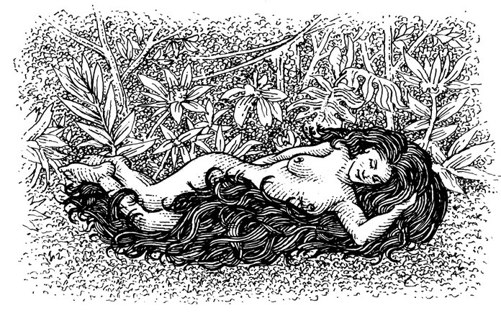A Field Guide to Lucid Dreaming (26 page)
Read A Field Guide to Lucid Dreaming Online
Authors: Dylan Tuccillo,Jared Zeizel,Thomas Peisel

and again throughout many dreams. The psychotherapist wrote
about his experience: “Philemon and other figures of my fantasies
brought home to me the crucial insight that there are things in
the psyche which I do not produce, but which produce themselves
and have their own life. Philemon represented a force that was not
myself. In my fantasies I held conversations with him, and he said
things which I had not consciously thought.”
If this story seems a bit nuts, here’s the real puzzler. Many
years after Jung dreamed of this figure named Philemon, author
Robert Moss dreamed repeatedly of a man who also called him-
self Philemon. Moss swears that he had never read Jung’s writings
I was kinda obsessed with the idea of dream characters. Because
it kinda went to the core of who we are, you know? If I’m con-
scious and I know I’m in a dream, and this thing is talking to me,
and it seems to have its own consciousness, is it separate from
me? So I became lucid and I was going through this square,
cobblestones and it was nighttime. I eventually came to this
guy and I’m like, “What are you? Are you me or you you?” he
looked at me and rolled his eyes and walked away. So I go up
to this other guy and ask, “What are you?” And he just looks at
me and says, “That’s not important.” So, maybe I need to ask a
better question. I ask him, “What’s important for me to know?”
So he looked up at the sky and pondered for a while. “hmm.”
Then he looked down and made eye contact with me and said,
“you don’t do what you want to do.” —MATT c.
=
163
<

at the time and was not aware that he shared the same “guide” with
the deceased Jung. It was only years later that he made the discov-
ery. And imagine his surprise.
FOOD FOR THOUGHT
Many cultures believed in some kind of dream sharing, notably the egyptians,
the ancient chinese, and many indigenous cultures. do we share more dream
experiences than we realize? If this is the case, here are some potential reasons
why we are forgetting: (1) we don’t remember our dreams, (2) when we
dream of someone else we don’t always share it with them the following day,
or (3) we are unconsciously consumed by our own private projections while
we dream and therefore too wrapped up to connect with our fellow dreamers.
These sorts of experiences make us wonder whether or not
there is a shared space, a place that Jung called the collective
unconscious. Could it be that dreams act more like the video game
Second Life, where we meet other dreamers in a common land-
scape? Could it be possible to meet our good friends in dreams
and share experiences? Are we already doing so and only forget-
ting? Such a phenomenon, called dream sharing, is already being
investigated. It is up to us as conscious dream explorers to find out
more and delve into these kind of experiments.
=
164
<
Coronado’s Big Mistake
Francisco Vásquez de Coronado wore his absurdly bulbous
metal hat, a sign that he was a Spanish conquistador. But the
Indians of the Rio Grande knew very little about Spain. All they
knew was that this strange white man was burning down their
homes and slaughtering everyone in sight, back in the bitter winter
of 1540. That spring, an Indian approached Coronado with tales
of a rich, golden city to the north. This man, who the Spaniards
called “The Turk,” led the conquistadors through the buffalo
plains and all the way to Central Kansas, a journey that took sev-
eral months.
They looked everywhere for riches and treasure, but all they
found were naked, bow-wielding Indians. “Neither gold nor silver
nor any trace of either was found,” Coronado famously remarked.
The Turk had purposely led Coronado astray so that his people
could be free of the conquistadors. He paid for this deception with
his life.
You’ll have your own encounters with the natives, so let’s learn
from Coronado’s mistake. Be nice to the local population. We
don’t know who the natives are, and we don’t always know exactly
what to say to them, but we do know that they are important and
deserve our friendship.
=
165
<
�
Summary
• The natives are not merely cardboard cutouts.
• Each native has its own level of awareness; they exist on a
spectrum of intelligence and wisdom.
• Dream characters provide guidance, intimacy, and advice, so
don’t ignore them!
• No one knows exactly what the natives are.
=
166
<
14
Superpowers
<•=
What we think, we become.
—Buddha,
spirtual teacher, available in both skinny and tubby varieties
Human beings have always had the desire for abilities
beyond the normal scope of possibility. From the earli-
est records of human civilization we have been obsessed
with gods, the supernatural, and those who exhibit powers of
another world. Just look at your local megaplex listings: superhero
movie after superhero movie.
Fantasies of the paranormal seep into our imaginations. We
ask each other, “If you could have a superpower, what would it
be?” knowing full well that this is a thought experiment. But once
we pass into the land of dreams, fantasy becomes a reality.
In this chapter we’ll open your eyes to skills that you never
dreamed were possible. Get ready to leave the constraints of the
waking world behind as you discover what you’re really capable of.
=
167
<
While you can take on any special power that you desire, for this
chapter we’ve chosen three superhuman talents: shape-shifting,
telekinesis, and manipulating energy.
We recommend that you pick a superpower you like and try to
stick with it. If you want to give telekinesis a go, don’t just attempt
it once. While it’s fun to try out a superpower, it’s even more fun
to master it.
Shape-Shifting
Imagine yourself as a dolphin, exploring the sea, or as the
president of the United States. What would it feel like to be a
cheetah hunting on the African plains? Perhaps you’re curious to
experience a day as the opposite sex. As your kindergarten teacher
told you, you can be anything you want to be, but this time you
don’t need to wait until you grow up.
Shape-shifting is not new. It’s one of the oldest practices of lucid
dreamers, especially among the many indigenous cultures of the
world. Before we teach you how to shape-shift, it’s important to
remember that the dream body is completely malleable. The body
you inhabit during your dreams is imaginary, a projection of what
your mind thinks your body looks like. This projection often changes
within our normal dreams. Our friend Matt thought about becoming
a woman in his dreams, and suddenly he was a forty-year-old soccer
mom. “And the strange thing is that I felt like a woman too,” he said.
Shape-shifting is about intentionally altering that self-image,
leaving behind the “safety” of your familiar form, transforming
into something different.
=
168
<

Keep in mind that shape-shifting requires practice. Our self-
image is hardwired into us, a stubborn neural pathway. For most
dreamers it will take some time. Don’t get frustrated, just keep at it.
1. Shift your shape.
Before you go to sleep, decide what person,
beast, or object that you want to transform into. After a wake-
back-to-bed, focus on that intention. If you’d like to become a
tiger, imagine what it would be like to have fur or to walk on
four muscular limbs. Asleep, you become lucid in your dream, and
now it’s time to shape-shift. Again, imagine your desired form and
make it tactile, feel the sensations that a tiger would feel. Stand
on all fours, feel your teeth getting sharp. Close your eyes and say,
“When I open my eyes, I will be a tiger.” Your dream body can
assume whatever shape you want it to.
=
169
<




